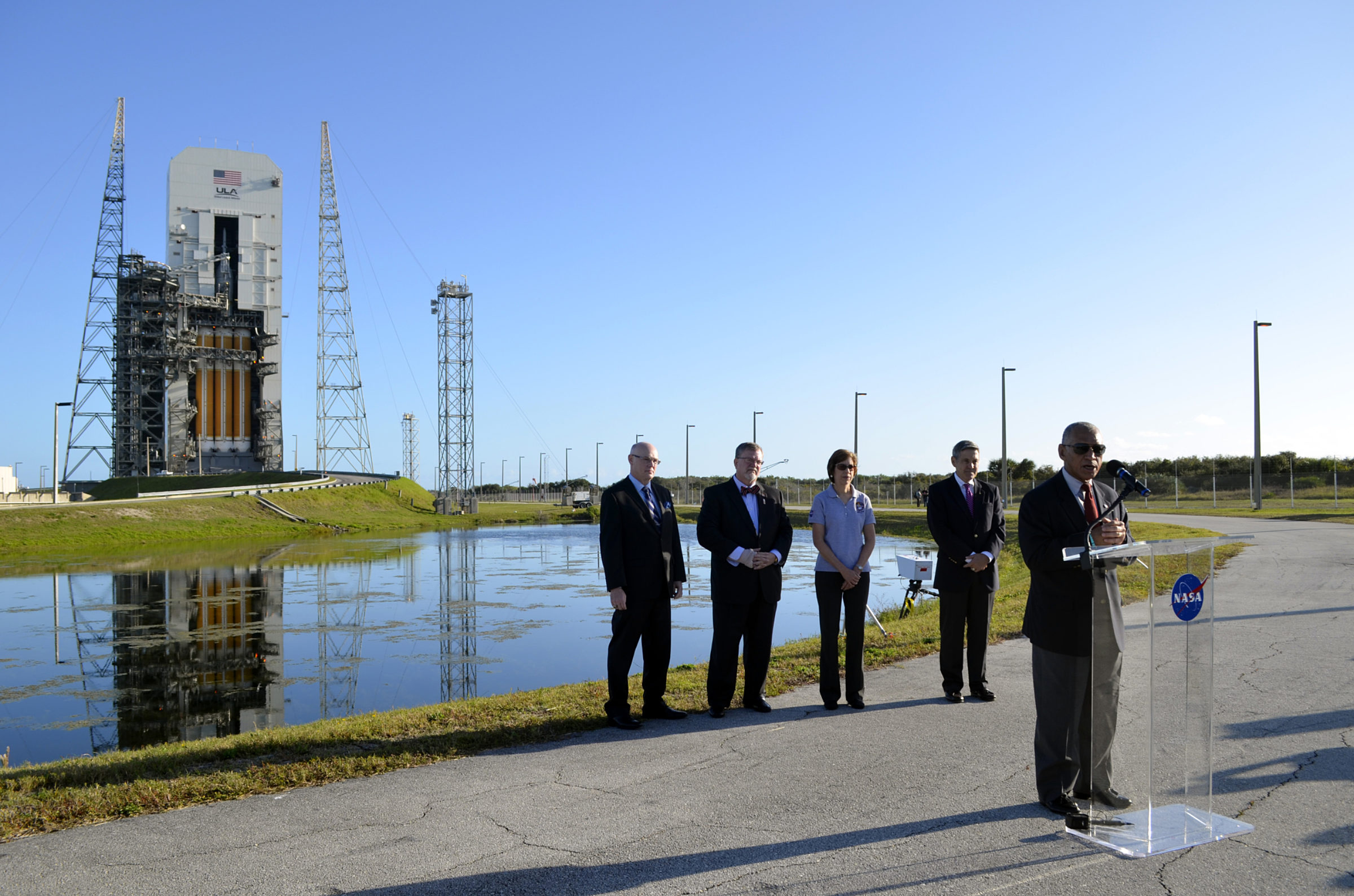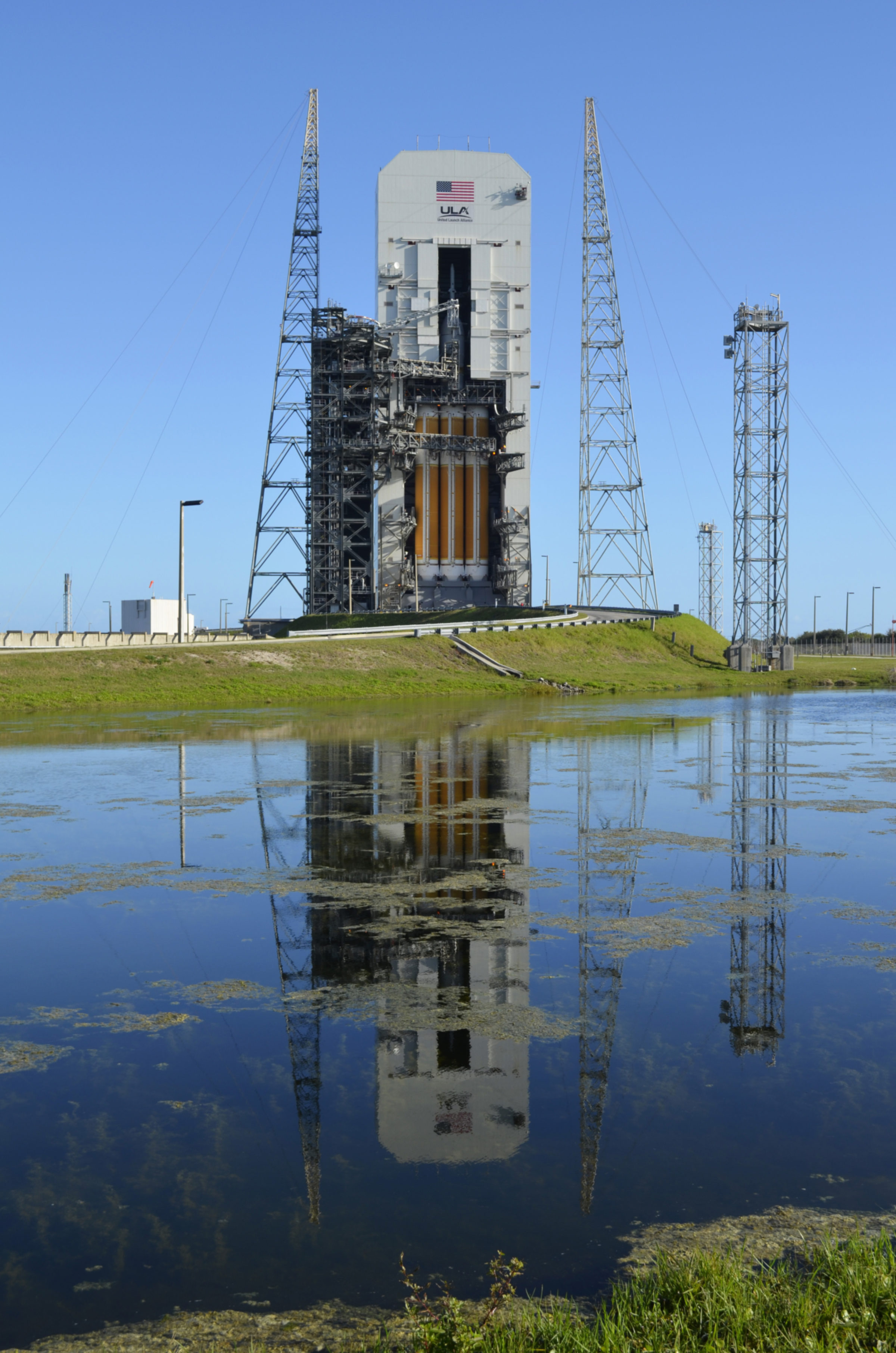Jason Davis • Dec 03, 2014
Orion L-1 Report: Go for Launch
The stage is set for NASA’s Orion spacecraft to launch on a two-orbit, four-hour shakedown cruise tomorrow morning. With less than a day remaining before liftoff, Patrick Air Force Base’s 45th Weather Squadron changed their forecast of an on-time launch to 70 percent—up from the 40 percent chances that marked the start of the week.
Standing in front of Orion’s Delta IV Heavy rocket Wednesday morning, NASA Administrator Charles Bolden was not shy about emphasizing the importance of the spacecraft’s maiden voyage. “What you see behind us is what I would call history in the making. Tomorrow is a giant day. It’s a huge day for us,” he said.
The scene at Cape Canaveral Air Force Station’s Space Launch Complex 37 was framed by mild temperatures and clear, blue skies. As if on cue, a butterfly approached Bolden, who paused to acknowledge it. “Did you all catch that?” he said. “The only thing better would have been if it had landed on my shoulder.”

Orion Program Manager Mark Geyer told reporters at a Wednesday press conference that Orion’s test flight was on par with other historic human spaceflight firsts. “In a sense that we are beginning a new mission, it is, I think, consistent with the beginning of shuttle; the beginning of Apollo,” he said.
Launch activities kick off this evening at 10:50 p.m. EST (3:50 UTC Thursday), when the Mobile Service Tower surrounding Orion and the Delta IV Heavy pulls away from the vehicle stack. Fueling is expected to begin at 2:35 a.m, with non-stop NASA TV coverage starting at 4:30 a.m. and lasting through splashdown. Launch is currently scheduled for 7:05 a.m.
Click here to see a detailed schedule of Orion EFT-1 launch events.
Once Orion reaches its preliminary, 185 by 888 kilometer orbit, the spacecraft will make one lap around the Earth. Then, the Delta IV Heavy’s upper stage will re-ignite, kicking the spacecraft up to an altitude of 5,800 kilometers—about 13 times higher than the International Space Station. Orion will pass through the Van Allen radiation belts, subjecting the spacecraft’s computers to an in-flight surge of charged particles.
Assuming Orion launches on time, it will slam into the upper regions of Earth’s atmosphere at 11:18 a.m., at a blistering speed of 32,000 kilometers per hour. Its heat shield could reach 2,200 degrees Celsius, simulating reentry conditions it will face during missions beyond low-Earth orbit.
The parachute sequence is scheduled to start at 11:24 a.m., when Orion’s forward bay cover is jettisoned, revealing the so-called flowerpot that contains the vehicle’s parachute systems. Two drogue chutes will deploy first, before the three main parachutes unfurl. Splashdown is set for 11:28—just 10 minutes after Orion hits the atmosphere.
Jeff Angermeier, the ground systems mission manager for Orion’s test flight, said the USS Anchorage and USNS Salvor left Naval Base San Diego on Tuesday for the recovery site, which is located about 160 kilometers off the tip of Baja California. The Anchorage is the primary recovery ship. Navy divers will approach Orion in rigid-hull inflatable boats and connect tow lines to the bobbing spacecraft. It will then be hauled into the flooded rear well deck of the Anchorage. If the Navy has any problems during recovery, the Salvor—which is equipped with a crane-lift system—will be standing by to assist.

Back at the Kennedy Space Center, enthusiasm filled the air. "I haven’t felt this kind of excitement in the air at Kennedy in a long time,” said astronaut Rex Walheim, speaking to a group of attendees at a NASA Social event. Earlier in the day, Kennedy Space Center Director Robert Cabana agreed: “I feel like the Blues Brothers, like we’re getting the band back together.”
For NASA, Orion’s launch is a major milestone. It’s equally important for Charles Bolden, who has overseen the completion of the International Space Station and the retirement of the space shuttles during his tenure as NASA administrator. He is pleased that Orion is attracting a large amount of attention, and hopes large crowds will come out to see Orion on its way. “I hope the causeway is lined with cars,” he said.
The Time is Now.
As a Planetary Defender, you’re part of our mission to decrease the risk of Earth being hit by an asteroid or comet.
Donate Today

 Explore Worlds
Explore Worlds Find Life
Find Life Defend Earth
Defend Earth

